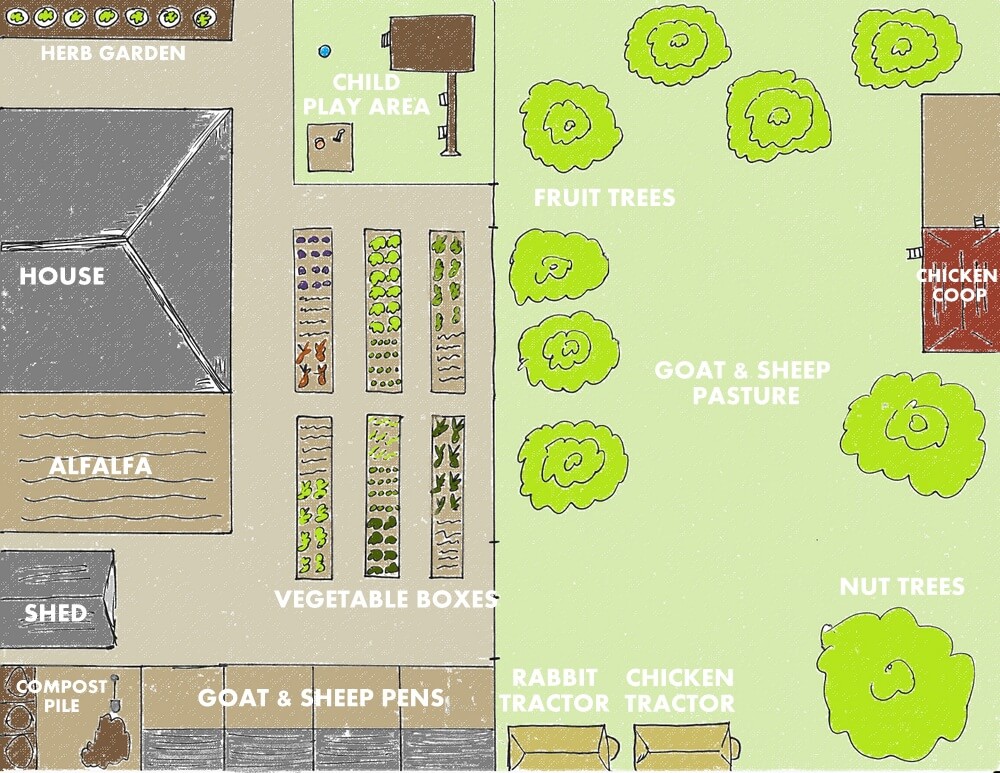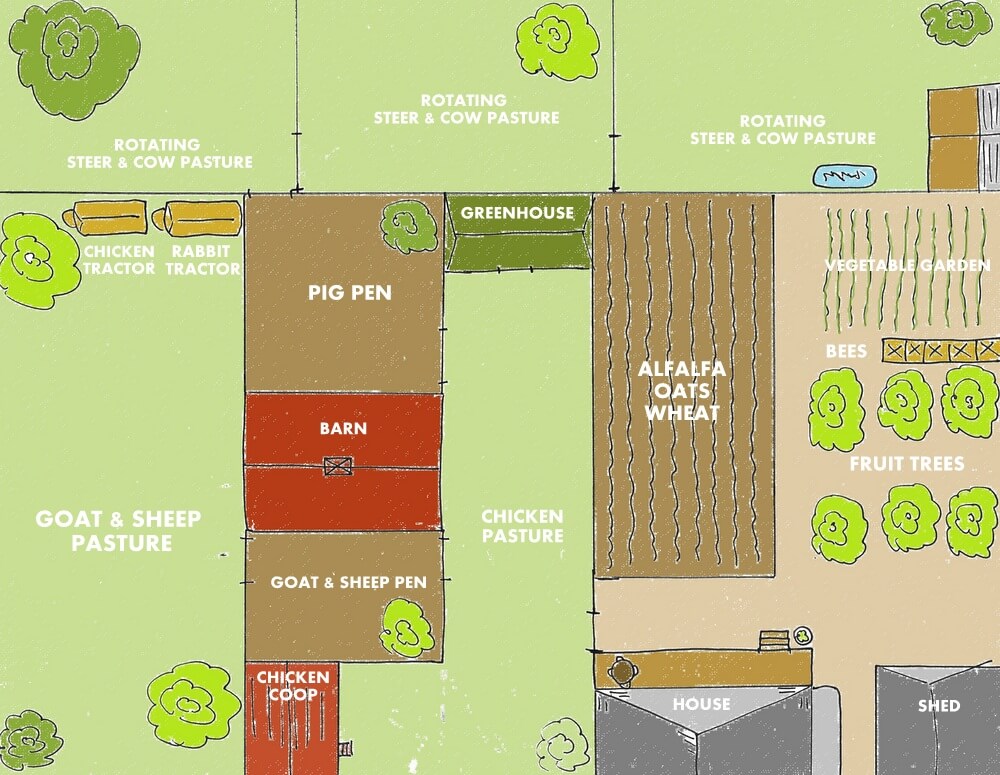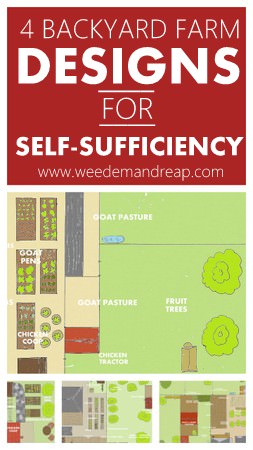
I love designing backyard farms. Even if they aren’t mine.
Actually, especially if they aren’t mine. Let me tell you how to farm and then you go do the work, okay?
Sound good? Okay, let’s get started!
There are a few important things you need to remember when creating or researching backyard farm designs.
Among them are which animals can be companions, the accessibility of your animal areas, and how to simplify with sustainability practices.
Let’s start with the animals:
- Goats and sheep are buddies, but you need to make sure breeding males don’t have access to them at all times. And definitely don’t encourage cross-breeding! Ask me how I know.
- Chickens can be around cows, sheep and goats, but it’s best to allow chickens access to lots of areas (like the road! Hahahahahaha, not really). If you keep your chickens with your milking animals, the chicken poop may get around an udder, which is not good. If that udder’s providing your family’s milk, you need to look out because there’s a higher chance of campalobacter and e. coli. I’m not saying you need to freak out if you chicken roams around your milking animals. But I wouldn’t keep the chickens locked in the goat pen, if you catch my drift.
- Pigs are omnivores, which means they will hunt and eat other animals if given the chance. For this reason pigs need to be with their own kind. But if you rotate your pasture, you can give the pigs a turn in each of the various pastures.
Now on to animal containment:
- Because meat chickens are fully grown by 10-12 weeks old, for a large part of their lives you’ll be raising baby chicks. To avoid confining them to a small area that will be run down quick by all those feet (and will get filled with poop), it’s best to build a chicken tractor. This is basically a movable cage that allows you to move them to a new spot of grass everyday or so.
- Most people think meat rabbits should be kept off the ground and in small cages, but a more natural alternative is when you can raise rabbits in their natural environment. That means grass. You can make a rabbit tractor (similar to a chicken tractor) but you need to put chicken wire on the floor of it to make sure they don’t dig their way out.
Don’t forget about the environment!
- If you want to make your own compost, it would be best to put your compost pile close to your animal pens. It’s even better if your garden is close to both of them. Convenience, hellloooo.
- If your fruit trees are fully grown, then you can allow your goats and sheep to be around them. Actually, they will help trim the bottom leaves and eat the fruit that falls on the ground so it doesn’t rot. But if your fruit trees are young, watch out! Your sheep and goats will have those new fruit trees eaten up in no time.
- In any case, all your trees should have a wire or lattice covering around it. Goats, sheep and cows tend to strip the bark of the tree trunks.
You’ll need to take into consideration all of these factors when planning your backyard farm.
Now let’s get to my plans! These are all for different sizes of yards. Whether you live in a small condo/house, a house with a good sized backyard or even on a couple acres, these plans should help you in determining the best way to design your backyard farm.
Small Backyard
1/4 Acre
1/2 – 1 Acre
2-3 Acres
Other Resources for planning your Backyard Farm/Homestead:
Your Custom Homestead by Jill Winger of The Prairie Homestead
Contrary to popular belief, a homesteader doesn’t have to be someone who lives on hundreds of acres with the perfect red barn and a white picket fence.This book really helps you organize all of your thoughts about homesteading into one obtainable dream. Get inspired by Jill’s amazing skills!
The Backyard Homestead teaches you how to grow the vegetables and fruits your family loves. It also shows you how to keep bees, raise chickens, goats, or even a cow. When the harvest is in, you’ll learn how to cook, preserve, cure, brew, or pickle the fruits of your labor. So many lessons, so little time!
Mini-Farming, Self-Sufficiency on a 1/4 Acre is a holistic approach to small-area farming that will show you how to produce 85 percent of an average family’s food on just a quarter acre. It’ll also show you how to earn $10,000 in cash annually from your farm while spending less than half the time that an ordinary job would require.
Backyard Farming on an Acre (More or Less) is written by someone who has planned and run a successful small-scale farm. This book will help you decide what should be grown or raised, implementing proven sustainable techniques that will yield a maximized harvest.










Marvelous post
Thanks
Thank you for sharing the designs and the books. Can you add some measurements into the design. For example: the dimensions of the pastures, or goat pens, etc. Even estimations would help a lot. I am at the planning stages.
Hello Mamadou-
I am sorry, but DaNelle doesn’t have measurements for these, they are just suggested was to position your farm. Some of the books that are suggested can help with some of that information.
Thank you -Bobbi (DaNelle’s Assistant)
Thanks for sharing the design of backyard farms.
My fiance and I are in the process of purchasing our first home together with 11.21 acres. I am ecstatic about the idea of homesteading for the first time since my oldest was in elementary school and she will soon be 29 years old. I am tired of the city life and tired of renting. All my kids are grown now and, thanks to a multitude of chronic illnesses some of which are rare, I am unable to hold down a public job so I am on disability. I am looking forward to having that sense of accomplishment again that my crafts just don’t give me. For the past year I have been working on what animals I want to have, the fruit trees I want in the orchard,what to put in the vegetable garden, etc. Needless to say the list has taken a mind of its own lol. I will have to get it under control and start small and add to it as we go or he may just divorce me before he marries me. Anyway, I was wondering if there is any advice you can give or ideas for someone like me just starting all over again.
Hi Brenda-
It sounds like you have some great future plans! This article of DaNelle’s is a great place to begin: https://www.weedemandreap.com/urban-farming-getting-started/
I hope that helps and your list becomes a reality!
Best wishes!
Thank you -Bobbi (DaNelle’s Assistant)
My husband and I are in the process of purchasing 10 acres and would love to be more self sufficient. Any good plans for that amount of space?
Hi Charity-
I wanted to let you know that DaNelle has some really great planning articles that could be very useful to you. Check them out here: https://www.weedemandreap.com/category/animals/farm-planning/
DaNelle is an amazing homesteader and so great at planning smaller urban farms, however she is not an expert in planning larger farms. A useful resource for you could be Joel Salatin’s books. He gives some great advice about larger farms in them.
I hope this helps! Best of luck with everything! -Bobbi (DaNelle’s Assistant)
DaNelle,
I wonder if your work brings you in contact with people wrestling with city regulations on gardens and small farming operations.
If that is the case you may be interested to learn about a new political tactic that is proving successful in Texas. This is a form of direct democracy that can be put in play to protect urban farmers and small agricultural operations.
Sens me an email and I will respond with links and attachments.
Barry Klein
Pres./ Houston Property Rights Association.
713-224-4144
Thanks, Barry!
Love the plans!!!! I am a newbee and will gladly use your plans to gets tarted on my micro farm. My goal is to teach other how to feed themselves on an homestead like you do. I do want to add trying other farming methods though. Like raised beds, hydroponics, and aquaponics. Have you done any of this and if so… Is location relevant?
Hi Sheena,
Yes, all those methods require adjustments depending on where you live, but it’s totally possible!
Wow, stunning site. Thnx ..
Use a tire around your trees so the chickens don’t peck at the roots and put the chickens with the trees, they are smaller than goats so it’s better ( if the goats big enough it will jump up, reach the fruit on the tree and eat it, and destroy the tree ).
Wont the tire contaminate the fruit over time
I researched that and the tire is supposed to be safe as long as it in one piece. Once you cut or shred it tjen the chemicals leach out.
This is extremely helpful! I’ve been racking my brain trying to figure out how to plan out my new garden. I don’t have any experience and just started my own blog to document turning my large backyard into my own little homestead. I look forward to reading more from you and thank you!
Please do you have any book for this ?
I like this one here: https://amzn.to/1QLnUtQ
I didn’t see any mention of how many animals you have allotted for each area. I have information from our county extension office that states you should have 1 acre per steer/cow. What are the dimensions of these areas?
Wow. … Not one design included Aquaponics! I have 20 rainbow trout growing to dinner plate size very fast, then the grow bed for the vegies is highly productive. Strongly suggest you look into it and include in the designs!
Very interested in learning aquaponics
Love these plans. My wife and I just moved into a beautiful house on 3 acres. Would love some assistance on planning the layout!
Thanks for sharing these small farm designs. I didn’t realize you could do so much, with such a small amount of land!
If we don’t eat wheat, but do intend to raise ducks (for eggs mostly) how would you suggest setting up 4 acres? It’s actually 4.6 but I want some house and yard space for the kids.
I would definitely use a large portion of that for pasture! What a great opportunity to have so many acres!
Is there a program you used to make these up? We are buying property and I’d live something like this to help me plan!
Hi Rachel, I just drew it out, actually, then scanned it:)
Hi is there a way to keep my free range chooks out of my garden they are free to go anywhere on our 5 acres
Hi Robyn-
I find simply asking them not to go in the garden works pretty well. 😉 Just joking.
Seriously though, chickens can do some real damage in your garden. The best solutions I have found are to put a fence around the garden using chicken wire or something similar they can’t get through. You can also lay similar wire mesh flat over newly planted ground so they cannot scratch it up. If you have larger stand alone plants, placing large rocks or bricks around the base of them will keep chickens from digging them up. I also find actually planting a separate “chicken garden“, away from your garden, really helps. This is a garden that the chickens are free to eat from and dig in. It supplies them with food and it distracts them from your garden.
I hope this helps! Best of luck and Happy Gardening and Chicken Raising! -Bobbi (DaNelle’s Assistant)
Just found out I’m zoned for chickens and recently started plans for a garden. That being said.. We have a small back yard and two children. The mention of e. Coli and such in the chicken poop makes me nervous. I had heard of people just giving the chickens scraps and using their poop to fertilize their gardens but now I’m wondering if the poop poses a hazard to fresh fruits and veggies and my mouthy little ones?? Any insight for a newbie?
As long as your chickens are living in a spacious, natural environment, it will be fine:)
Abbey
We had 35 laying hens and 50 meat birds on 2.64 acres in Maine. My kids were 5,4, and 3 when we started our homestead. We added geese and rabbits later. the chicken poop from the coop was composted before we put on the garden ( it is actually too hot to use right away. rabbit poop we could use from under the hutches to the garden. None of the kids got sick from poop that was in the yard. Now my youngest was totally involved in the animals playing with them when the other 2 were in school. she had the chickens trained to fly on her arm like a parrot would. She took it upon herself to get up early and get eggs every morning no matter what the weather was and a few times thought we would loose her in the deep snow. The only thing i remember they got sick with in the 7 yrs we lived on that homestead was chicken pox, brought home from school and shared it with me. So i would not worry about chickens free ranging in your yard and the children playing
🙂
I love this! I grew up on a farm and I have always had a garden no matter where I’ve lived. I currently have 6 raised garden boxes and an herb garden outside the back door. We live in town for now, but I am hoping that when we retire we will be able to have at least 5 acres… I have taught several people how to grow their own food. I think it’s something that everyone needs to know. I’m not crazy about sheep, so I won’t ever raise those, but I do buy the wool when it’s sheared off in the spring. I know how to deal with it too.. from carding to spinning, dying, knitting or crocheting.. I was very fortunate to learn all these things on a farm in the foothills of the Appalachia’s. Thanks for posting this and making life a little easier for the homestead farmer!!
Kudos,
Laura
The Google+ isn’t allowing to share thru that link, it must be broken. Just wanted you to know.
Thanks Kelly, I’ll look into it:)
Plans are nice except for one thing. You can keep fruit/nut trees in a goat pasture, they will “ring” them and kill them. Goats love fruit trees. Everytime mine got loose out of their pasture they would head right for my orchard and rub a ring around the tree, which kills it. I would not recommends this. Goats are destructive, however, there are some trees they will not harm, like oak trees.
Cathy, the very last comment on the list at the top was… In any case, all your trees should have a wire or lattice covering around it, as goats, sheep, & cows tend to strip the bark of the tree trunks.
Pitted fruit trees should never be planted where goats are pasturing.
I like those plans! It’s amazing what can be done on any size lot, isn’t it? I am in a typical suburban neighborhood with only about 3000 usuable square feet. I have 8 4’x4′ raised beds (and can fit 6 more where they are), a 4’x4′ rabbit hutch/run (on dirt with fencing to cover so that they can dig and dig, but can’t escape) and a 4′ by 8′ foot chicken coop with an attached 6′ x 10′ covered run (you thought 4′ was gonna show up there huh?). That coop houses 7 chickens and 4 Muscovy ducks (they are only really in the run in the early morning, they roam all over the yard during the day. I also have 7 fruit trees in half-barrels. If it weren’t for the fact that 1/3 of the yard is fenced off for the dogs (one of whom likes to play with the ducks. The ducks aren’t crazy about how he plays) we’d have even more here. This is my “homestead” until we can move and get more land.
I really like the plans you posted, they give me great ideas!
Dear friend,can u give a plan for 1/4 acre sustainable farm with dimensions of area..(ie, 10 feet × 20 feet 10’×20′-cattle fence)..it will be more useful for all,….